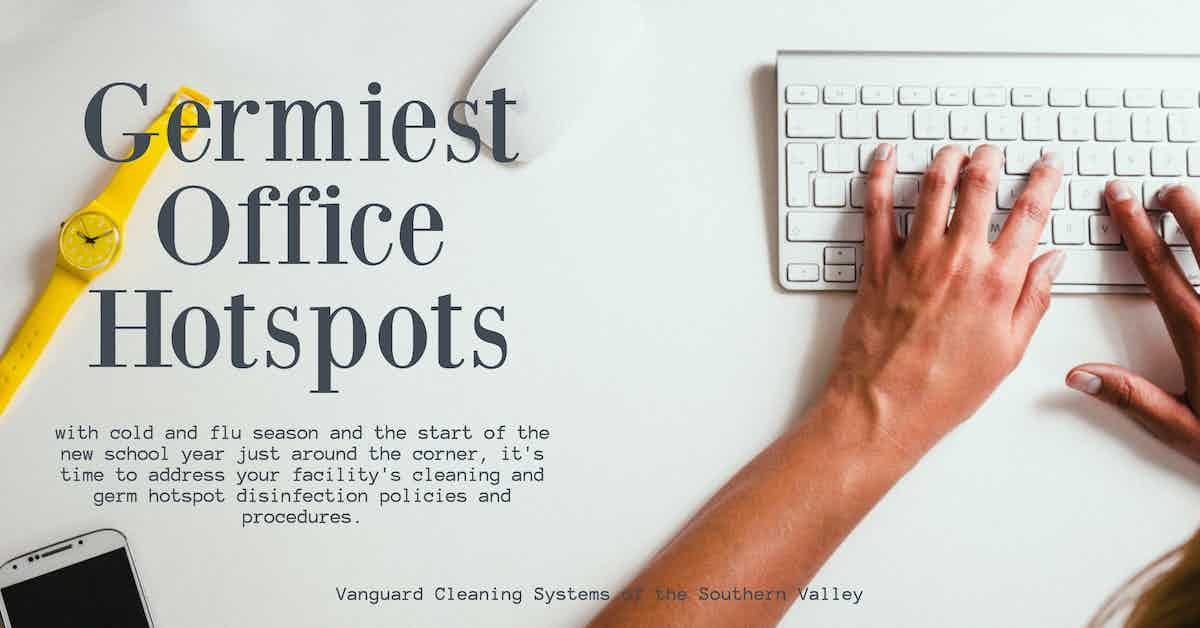With cold and flu season and the start of the new school year just around the corner, it's time to address your facility's cleaning and germ hotspot disinfection policies and procedures.

Hybrid Working Models Contribute to the Spread of Office Germs
The hybrid working model--home part-time and office part-time--combined with communal workspaces and hot desking contributes to the rapid transmission of germs and bacteria, resulting in increased rates of illness and decreased worker productivity and mental wellness.
Over 50 percent of American workers are currently working from home more than four days each week, and a third of workers indicate a preference to be fully remote.
The move to hybrid working also means that when employees come into the office, they often do so specifically to meet with their co-workers in communal spaces.
Coupled with the rise in “hot desking” or “hotel desking,” where almost a fifth (19 percent) of all American office workers now have no assigned desk, this combination can lead to shared surfaces being touched more regularly by different people than in a pre-pandemic office.
As a result, illness-causing germs travel around the workplace differently than before.
A team at Lysol Pro Solutions conducted research into how the change in working models has impacted the presence and transmission of illness-causing germs in the workplace.
According to their results, the top 10 germiest office hotspots are:
- Elevator Buttons
- Coffee machine handles/buttons
- Refrigerator doors
- Kitchen sink tap/handles
- Vending machines
- Door handles
- Keyboards & mice
- Telephones
- Shared printers
- TV remote controls
Germ Hotspot Mitigation Methods
Reducing the detectable levels of germs and bacteria on commonly touched office surfaces will significantly reduce transmission and illness.
Ideally, hotspots should be wiped down with an EPA-registered disinfectant after each use.
However, not every facility can afford the labor resources necessary to facilitate roving day porter cleaners.
A proven solution for that challenge is to make disinfecting wipes, hand sanitizer, and basic surface sanitation training available to facility occupants.
Wipes and hand sanitizer should be conspicuously placed as close as possible to the hotspot to encourage high compliance levels.
To achieve the highest standards of cleanliness and hygiene, the occupied areas of a facility should be professionally serviced daily using a combination of wet and dry cleaning methods intended to remove dust, soil, germs, and bacteria.
Additional deep cleaning and professional infection control measures leveraging electrostatic sprayers should be employed based on several criteria:
- Facility type
- Occupant risk
- The existence of any community-wide outbreaks
- Facility contamination and;
- An uptick in reported illness associated with facility occupation
In the average U.S. office building, deep cleaning and disinfecting can typically be safely performed once per week alongside a regular health-based cleaning program.
Takeaway
Hybrid work models, hot desking, communal office environments, and hotel desking contribute to the increased transmission of germs in the workplace.
Additionally, the shift away from conventional office working models has changed where illness-causing germs and bacteria are commonly found.
Further, the need for an increased rate of disinfectant for high-touch surfaces in high-occupancy workplaces has placed many organizations in a bind that requires navigating between rising costs by onboarding additional day porter cleaners and leveraging facility occupants to sanitize private and shared workspaces.
Ideally, due in no small part to the potential hazards associated with commercial disinfectant handling, use, and disposal, only trained professionals would be used to wipe down facility fomites during the day, following by regular cleaning services and weekly deep cleans.
However, onboarding the requisite labor and material resources to achieve and maintain sustainability goals long-term may prove cost-prohibitive.
Outsourcing is a proven method for onboarding highly in-demand cleaning and disinfection services and experience for a fraction of the price of maintaining a similar service in-house.
If you would like more information regarding the effectiveness of high-performance infection prevention and control measures, or if you would like to schedule a free, no-obligation on-site assessment of your facility's custodial needs, contact us today for a free quote!
In Bakersfield, CA, call (661) 437-3253
In Fresno, CA, call (559) 206-1059
In Valencia, CA, or Santa Clarita, CA, call (661) 437-3253
In Palmdale, CA, or Lancaster, CA, call (661) 371-4756

